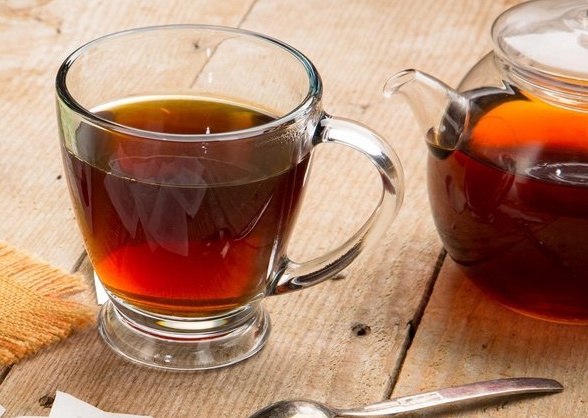Chaga Tea — Immune Boosting Super Drink

If you need to improve your immunity, boost your energy, and enjoy a phenomenal tea with maple texture and vanilla-like flavor, the answer is
Chaga tea!
Chaga is a mushroom with Latin name Inonotus Obliquus. It grows in the Northern Hemisphere on the bark of birch trees. It is consumed primarily as a very healthy tea and that’s the traditional way of using it.
The other ways of consuming Chaga are in a form of extracts, tinctures, powders, and tablets.
This mushroom is not so easy to find. It grows in the U.S.A, Canada, Russia, and Northern Europe, on the northeastern side of the birch tree. Typically, it picks up trees older than 50 years.
Chaga can easily be missed if you don’t know what you are looking for, because it doesn’t resemble a mushroom in any way. Chaga actually exists in a symbiotic relationships with the birch tree. It becomes an integral part of the tree. It takes years for the mushroom to show itself on the outside of the bark as a black cluster of mycelium with hard exterior. Inside, Chaga is brownish or orange, and this part of the mushroom is often preferred for its increased nutritional value.
The Siberian shamans revere Chaga as the king of all mushrooms!
This unusual mushroom is packed with health benefits and in this post we will be dealing with the most important ones. We will also see how you can prepare your own healthful drink out of it.
The benefits are mainly as a result of the Chaga’s antioxidant compounds, as well as because it contains substances that positively affect the immune system. It also includes more than 240 medicinal compounds, most of which have yet to be investigated. Chaga is a source of minerals, like copper, calcium, manganese, zinc and iron.
Table of Contents
- 1 Health Benefits of Chaga Mushroom
- 2 1. Immunity Booster
- 3 2 Anticancer Properties
- 4 3. Chaga Reduces LDL-Cholesterol and Triglycerides Levels
- 5 4. Helps Fighting Ulcers and Gastritis
- 6 5. Antimicrobial and Antiviral Properties
- 7 6. Antioxidant Properties
- 8 7. Better Liver Protection
- 9 Prepare Your Own Chaga Tea
- 10 Safety Information and Side Effects
- 11 Q&A
- 12 Is chaga a good blood thinner?
- 13 Is chaga good for diabetes?
- 14 Can chaga grow on oak tree?
- 15 How can I cultivate chaga?
- 16 References:
- 17 Related Posts
Health Benefits of Chaga Mushroom
If we take a look at the nutrition facts about Chaga, it is obvious that is rich in protein and phytonutrients. It contains ergosterol, which is a precursor of vitamin D2. The outer shell contains a lot of melanin — a powerful antioxidant and protector of the DNA. It contains beta glucans, betulinic acid, SOD, triterpenes,
Let us see how this rich nutrition content helps in prevention and treating various diseases.
1. Immunity Booster
The high concentration of Beta-D-Glucans is what makes this mushroom great for the immune system. Beta glucans are basically sugars. They are often found in bacteria, yeast, fungi, plants, and algae. Besides helping the immune system, their medicinal properties also include anti-cancer and anti-diabetes properties, and the ability to reduce high cholesterol levels.
Other bioactive compounds responsible for this immuno-boosting effect are the natural inotodial, and ergosterol peroxide.
The immuno-modulation properties of Chaga are very sophisticated. It can boost the body’s immunity when needed, or slow it down when there is too much activity. This effect of immunomodulation can greatly benefit individuals with autoimmune diseases.
People with auto-immune conditions, usually have elevated concentrations of substances called cytokines in their blood and tissues. Chaga inhibits cytokine production, as well as some other factors that promote inflammation.
2 Anticancer Properties
The Beta glucans have been investigated for their activation of the immune system in early stages of cancer. Chaga mushroom can be considered a potential anticancer agent for treating hepatoma [1].
Chaga helps inhibit cancer growth and spreading of metastasis. Another class of compounds that is probably responsible for these effects are the triterpenes. They are know to aid apoptosis, a process where cancer cells are forced to self-destruct. Chaga does exactly that without leaving any toxic traces in the human body. So, the functioning of the surrounding healthy cells is left intact.
3. Chaga Reduces LDL-Cholesterol and Triglycerides Levels
Research has shown promising results of Chaga’s betulinic acid in breaking down the bad, LDL cholesterol. In addition, it was found that the serum levels of total cholesterol, triglycerides, and free fatty acids are reduced [2].
Betulinic acid is also studied for its anticancer and antiviral properties.
4. Helps Fighting Ulcers and Gastritis
The antibacterial and immuno-modulation properties of Chaga make it perfect for fighting ulcers and gastritis. Today we know that stomach ulcers are caused by a type of bacterium called Helicobacter pylori, so chaga can naturally help calm stomach ulcers. It does so by reducing the number of these bacteria in the digestive tract and preventing their synchronization and communication. It helps reduce the inflammation on cellular level, which also aids in fighting ulcers and gastritis.
The chaga mushroom has a wide range of bioactive compounds with antiviral activity, as shown in a recent study carried out using chaga extract [3].
The extract of this mushroom has also shown antioxidant, and antimicrobial properties [4].
6. Antioxidant Properties
The antioxidant properties of Chaga are extraordinary. This is partly a result of its black exterior which contains melanin. Melanin is a natural black pigment that scores very high on the ORAC scale, more than some other foods already considered strong antioxidants. ORAC measures the antioxidant properties of many natural foods, and Chaga is very high on this list with more than 140,000 µmol of Trolox Equivalents per 100 grams of fresh produce.
Besides melanin, there is another class of biologically active compounds – the SOD. This refers to Super Oxide Dismutase, which is a kind of enzyme that protects against oxidative stress.
7. Better Liver Protection
Chaga is considered hepato-protective. It means, it protects the liver. The liver is one of the organs that suffer the most oxidative damage from free radicals and other reactive harmful molecules. If you eat too much junk food, or if you are exposed to environmental toxins, like cigarette smoke, than you can be sure that your liver is under increased danger from the excess of free radicals.
Moreover, research has shown that some liver diseases are a direct result of oxidative stress. (Oxidative stress as a crucial factor in liver diseases). [5]
Along with some other powerful antioxidants, Chaga can help neutralize these free radicals and the oxidative stress in the liver and other body’s organs can be greatly reduces.
Prepare Your Own Chaga Tea
Making tea is the traditional and by far the most popular way to use chaga. It is really easy and straightforward:
- Grind several small chunks of Chaga with a blender.
- Place one teaspoon of the Chaga power into boiling water. Alternatively, you can put one small chunk directly into water without grinding it. In this case, the recommended dosage is approximately 0.5 square inch of chaga per 10 cups of water. If you take more than that, your tea will be stronger.
- After a short boil, let the chaga simmer (at the lowest setting on the stove knob) for 10 minutes. The longer it simmers, the more bioactive substances will be extracted into the tea, so you can prolong this time.
- Remove from the stove and allow the tea to cool down.
- Strain the tea and enjoy!
Rather than rapidly boiling chaga — which may damage the healthful components — you should always use low heat and slowly cook the tea. The cooking time can be as long as 3 or 4 hours (for maximum extraction of nutrition compounds).
Safety Information and Side Effects
Chaga is generally well-tolerated.
Moreover you can drink Chaga tea in large quantities, and you probably won’t feel any side effects.
But, to be fair, no systematic studies exist on the clinical safety of this mushroom. Therefore, one cannot exclude some side effects in some people.
Chaga is known for its ability to lower blood sugar, so if you have diabetes or if you take medications for blood sugar control, you should consult with your doctor prior to using this mushroom.
The other side effect is related to Chaga’s ability to inhibit platelet aggregation, which means that you should be careful if you take blood thinners [6].
Q&A
Is chaga a good blood thinner?
Chaga is an excellent natural blood thinner. Be careful if you take any blood thinning medications.
Is chaga good for diabetes?
Chaga can help lower the blood glucose levels. You can check the experiences of diabetics consuming chaga tea here.
Can chaga grow on oak tree?
Most frequently you will find it on birch trees, white or yellow. Very rarely you can find it growing on beech, elm, and hornbeam. Ýou won’t find it on oak tree though.
How can I cultivate chaga?
Chaga takes many years to grow, and is not very common. Regrettably, you won’t be able to farm it, you should rather learn how to use wild-harvested Chaga. Moreover, you should learn how to harvest it in a healthy and sustainable way. The best guide we could find is from the chagahq.com.
References:
[1] Chaga mushroom (Inonotus obliquus) induces G0/G1 arrest and apoptosis in human hepatoma HepG2 cells.



Leave a comment